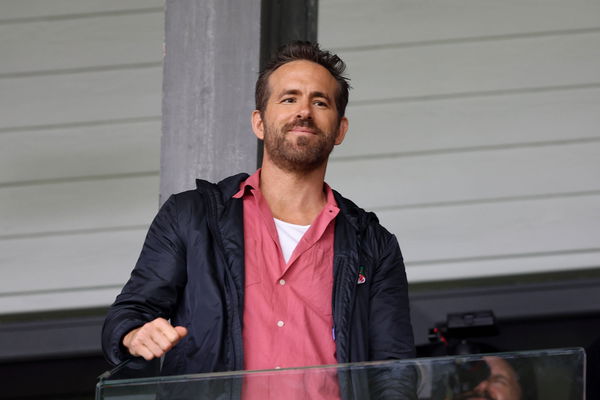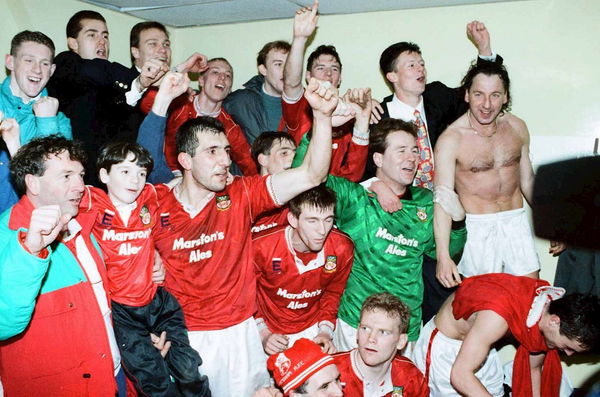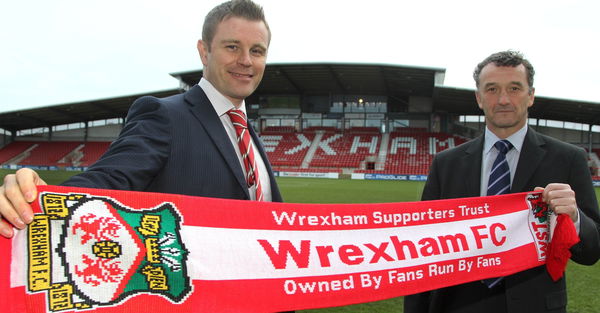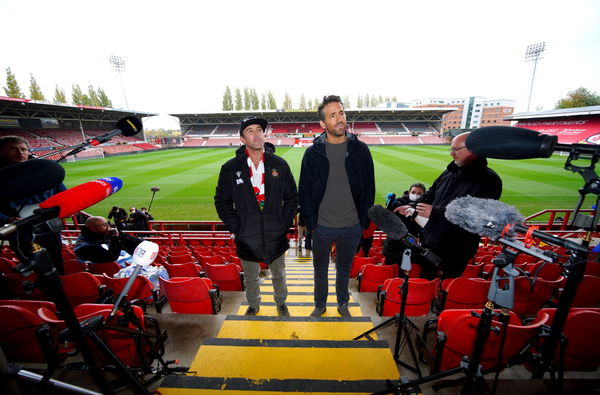
via Imago
Mandatory Credit: Photo by Paul Greenwood/Shutterstock 14039951ak Ryan Reynolds ahead of kick-off Wrexham v Milton Keynes Dons, EFL Sky Bet League Two, Football, Racecourse Ground, Wrexham, UK – 05 Aug 2023

via Imago
Mandatory Credit: Photo by Paul Greenwood/Shutterstock 14039951ak Ryan Reynolds ahead of kick-off Wrexham v Milton Keynes Dons, EFL Sky Bet League Two, Football, Racecourse Ground, Wrexham, UK – 05 Aug 2023
Wrexham AFC has become a household name in soccer. Only ardent fans of the beautiful game were aware of the existence of the Welsh club until Ryan Reynolds and Rob McElhenney came to give the team a global identity. From ending a 15-year exile in the National League to achieving back-to-back promotions, the Red Dragons are on the path to becoming a force to be reckoned with under the Hollywood owners.
Watch What’s Trending Now!
While this is the story you might have heard often, many aren’t aware of the life of Wrexham before the actors into the soccer scene. Today, we dive deeper to uncover the club’s historic rise under many ownership changes that span over 150 years.
ADVERTISEMENT
Article continues below this ad
How did it all begin for Wrexham AFC?
Founded in 1864, Wrexham is the oldest soccer club in Wales and the third-oldest professional team globally. It is believed that members of Wrexham Cricket Club established the team at the Turf Hotel, who just wanted a winter sport to play. Initially, the Dragons participated in friendly matches until 1876 when the Football Association of Wrexham (FAW) was created.
Though Wrexham began as pioneers, they competed in various tournaments such as the Welsh Cup and the FA Cup by the 1880s. However, financial struggles persisted. The club later joined The Combination League, but escalating costs forced them to join the Welsh League for the 1894–95 season. Despite reduced support, the savings on travel expenses outweighed the lower gate revenues.
ADVERTISEMENT
Article continues below this ad

From 1905 to 1968, Wrexham entered the Football League. Participation in various competitions and ticket sales from the Racecourse Ground bolstered the club’s finances. 1968–1982 was a period that marked their glory days during which they had also entered the European scene. Meanwhile, 1982–1991 saw their success graph take a turn for the worse as they were relegated to the fourth division.
ADVERTISEMENT
Article continues below this ad
Nothing changed for Wrexham in the 1991–92 season as they struggled both financially and domestically. Issues persisted for Wrexham after 2000, particularly involving then-chairman Alex Hamilton. Unfortunately, he attempted to evict the club from its very own stadium, Racecourse Ground to repurpose and sell it for his personal development projects.
From ownership maneuvers to the enforcement of Wrexham Supporter’s Trust
While Hamilton was disposed of with the help of Brighton and Hove Albion, December 3, 2004, saw the club being placed into financial administration by the High Court in Manchester. This was due to the debts totaling £2,600,000, including £800,000 owed to the Inland Revenue in unpaid taxes. A year later, the Birmingham High Court ruled against Alex Hamilton’s company, CrucialMove, for wrongfully acquiring the ground’s freehold.
This led Hamilton to appeal to the London court in 2006 that the stadium must remain with the club’s administrators. Eventually, administrators reached an agreement with local car dealer Neville Dickens, subject to approval from shareholders and creditors, which was granted on May 30. Luckily, Wrexham saved themselves from getting expelled from the league due to financial concerns if they had been under the administration until June 3.

via Imago
The WST press conference to officially give the insight into the ownership of Wrexham Spencer Harris and Barry Horne with the new scarf
Interestingly, in March 2011, the Red Dragon’s ownership attracted interest from the Wrexham Supporters’ Trust and local businesswoman Stephanie Booth. While the Welsh city’s MP and AM wanted WST to secure the bid, a third bid emerged at the eleventh hour. Yet, a contract between the WST and Booth led to their bid being reinstated. This was subsequently followed by a notice sent to Wrexham by the Football Conference for a bond of over $250,000 to retain their league status.
However, the club’s owners could only offer slightly over $150,000 forcing them to appeal to the Wrexham community for help. Fans generously contributed funds and the required amount was raised within seven hours and promptly paid. As Wrexham Supporters’ Trust continued to run the club, former player-manager, Dixie McNeil joined the board of directors. Fast forwarding to 2020, while their situation worsened due to the pandemic, a ray of light emerged.
And that ray of hope was none other than Ryan Reynolds and Rob McElhenney!
Around September 2020, Ryan Reynolds and Rob McElhenney voiced their interest in acquiring Wrexham after the club was open for a new ownership takeover. A meeting was set, virtually of course, where the discussion took place and the actors submitted a bid of $2.5 million, which was approved by the members of Wrexham Supporters’ Trust. The takeover was completed by February 2021.
“We want Wrexham to be a global force,” said an optimistic Reynolds. While many thought it was all hat and no cattle talk, people forgot that the Deadpool star has a lucky charm when it comes to investments. While McElhenney and Ryan Reynolds acted as chairmen, Humphrey Ker was brought in as the club’s executive director, and Shaun Harvey as director. Though in their debut season, they failed to win the promotion, the subsequent season saw them overhaul the squad with 18 signings.

Getty
Wrexham co-chairmen Rob McElhenney and Ryan Reynolds during a press conference at the Racecourse Ground, Wrexham. Picture date: Thursday October 28, 2021. (Photo by Peter Byrne/PA Images via Getty Images)
In the end, they managed to do the impossible and win the 2022 National League, breaking a 15-year hiatus from the Football League. The global interest was solidified with the release of FX documentary, ‘Welcome to Wrexham,’ which narrates the club’s past and the beginning of its new era. Not to mention the sponsorship deals that the owners brought. Aside from sold-out stadiums, A-listers like Will Ferrell and Hugh Jackman also came to watch matches at the home stadium.
This also brings up Reynolds’ plan to increase the capacity of the STōK Cae Ras. Arriving in League Two wasn’t the end of success as Phil Parkinson-led side managed to move up to League One in the 2023/24 campaign, marking their second consecutive promotion. Now, the journey continues as Wrexham has become a life-long beloved project for Ryan Reynolds and Rob McElhenney as they aim to reach the Premier League someday.
ADVERTISEMENT
ADVERTISEMENT
ADVERTISEMENT
ADVERTISEMENT


